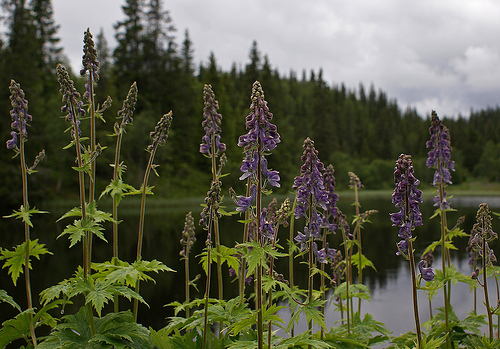Don’t let wolfsbane be the bane of your life!
- Wolfsbane is a genus of highly toxic perennial plants, found in the mountainous regions across Asia, Europe and North America.
- The scientific name of the wolfsbane is Aconitum and it is from the family Ranunculaceae, the family of buttercups.
- ‘Wolfsbane’ is also known as ‘monkshood’, ‘aconite’, ‘blue rocket’, ‘devil’s helmet’ and ‘women’s bane’, among others; and it is said to have been used as a method of killing troublesome wolves, hence one of the plant’s common names.
- Wolfsbane typically grows to be a height of 0.6 to 1.2 metres (2 to 4 feet), and it is often used ornamentally in the garden, especially towards the back of a garden bed.
- The blooms of wolfsbane are grouped along tall stems, and they are generally a blue or purple colour, though they can also be pink, yellow or white.
Wolfsbane
Image courtesy of Randi Hausken/Flickr
- Wolfsbane flowers are similar in appearance to a monk’s hood, and what appears to be five petals, are actually sepals.
- Wolfsbane consists of pseudaconitine, a toxin that is very poisonous, and a person (or animal) can be poisoned by consuming any part of the plant, though touching the plant may also be hazardous, especially if one has open cuts or abrasions.
- Wolfsbane poisoning can cause vomiting or nausea early on, leading to a burning feeling, weakness and numbness, and it usually affects the heart, often causing death within a short time-frame if left untreated.
- Sunny locations are preferred by wolfsbane plants, although they can still survive in shade, and they grow from tubers; or new plants can be started from seed.
- The toxic attribute of wolfsbane plants has not been neglected throughout history, as it has been used for both hunting, particularly for poison arrows, and assassination.
Bibliography:
Aconitum, 2016, Wikipedia, https://en.wikipedia.org/wiki/Aconitum
Buchan U, How to Grow: Monkshood, 2015, The Telegraph, http://www.telegraph.co.uk/gardening/11215801/How-to-grow-Monkshood.html
Rhoades J, Aconitum Monkshood: What is the Best Way to Grow Monkshood in the Garden, Gardening Know How, http://www.gardeningknowhow.com/ornamenta l/flowers/monkshood/growing-monkshood-plants.htm






